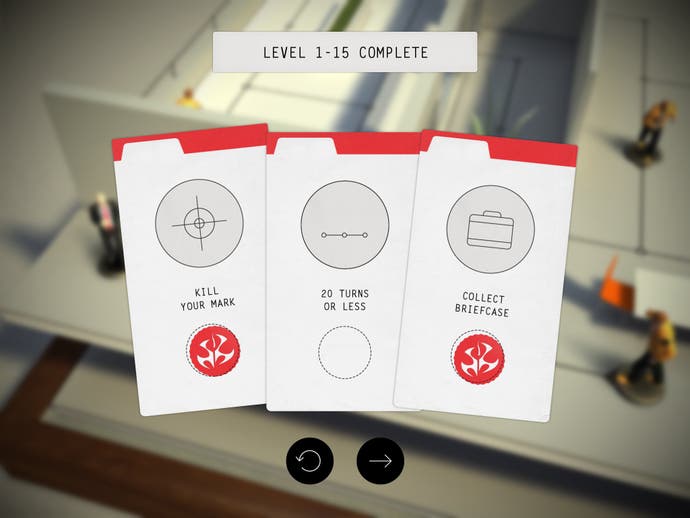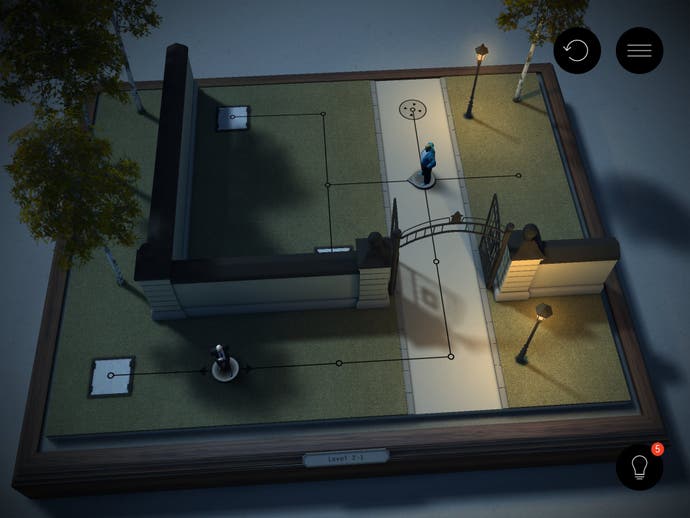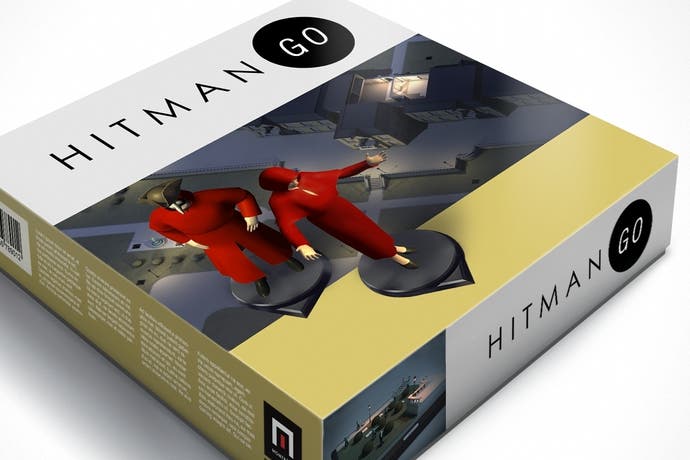Hitman GO review
Calculating.
At first glance, Hitman GO might seem like a strange departure for the series, a sudden and unusual tangent for the adventures of the cold, calculating killer named Agent 47. We're used to the Hitman games presenting us with a third-person perspective and placing us in environments that, at their best, are an assassin's sandbox, full of deadly tools and vicious opportunities. Our victims are as suspicious or oblivious as our actions warrant, as we don disguises, improvise weapons or engineer happy little accidents that help them meet their end.
Hitman GO is a very different game to play but, thematically, not really so far removed from its predecessors. It's still a game about being an assassin and it's still a game about being diligent, precise and methodical, with your ultimate objective being that clean kill, that tidy termination that concludes careful and intelligent planning. This time, however, your adventures take the form of something not entirely dissimilar to a sliding block puzzle.
Some people might tell you that Hitman GO is basically a board game, a digital representation of miniatures shuttling back and forth across a series of dioramas all too beautiful to ever know physical incarnation. And sure, it tries to present itself this way, with each of its hits depicted as an adventure brought forth from a box full of cards and playing pieces. But it plays much more like a clockwork toy, every scenario clicking away according its own logic, their characters strutting back and forth as reliably as automata marching out of a great clock on the hour, every hour. Until someone jams a blade in the mechanism, anyway. Someone like you.

It works like this: each hit is made up of a series of little vignettes and each of these presents you with a circuit-like grid across which you slide your Agent 47 piece, node by node, while everything else on the grid acts according to whatever simple, usually specific rule that it obeys. Guards in yellow suits always patrol along one axis, turning 180 degrees when they can't move forward any more and attacking Agent 47 if they move to a node in front of him. Guards in blue suits remain still, watching the node before them. Guards with knives rotate on the spot, also striking Agent 47 if they align to face him.
Move onto a node where a guard can catch you and you're out of the game. Surprise a guard, perhaps by moving onto their spot from behind, and their piece is removed. Your objective is always to finish on a particular node without being caught, one that either takes you to the next scenario or which contains your target. That, again, will be another finely sculpted miniature that you'll nudge out of play.
It all starts off very simple and, in time, sprinkles in more and more complications. Along with new guards who display new behaviours, there are objects that can be thrown to nearby spots, encouraging those guards to move and disrupting their behaviour patterns. Trapdoors let you spring up in different locations, climbing out of the floor like a garrotte-wielding David Copperfield. Move onto a node with a fern and its friendly fronds will hide you.

But, like so many of the guards who tick and twitch according to their regular, reliable schedules, you also must always keep moving. The world only moves when you do and Agent 47 can never sit on the same spot; he must always pick somewhere to step next. That fern is only safe for one move. That guard only has his back turned for one moment.
So you're carefully edging your way through all these moving parts and hoping to escape out the other side, receiving cards as rewards at the end of each scenario according to whether you fulfilled certain criteria. Did you get out? Did you reach your goal in a certain number of steps? Did you collect an item on the way? Did you avoid shedding blood?
It's not hard to foresee how complex things are going to get. Before long, you're looking at the sparsest of grids, layouts with few places to hide and watched over by far too many roving eyes and patrolling pugilists. In some cases, every single move counts and you find yourself thinking one, two, six steps ahead, calculating where guards will stand or be facing by the time you've slid onto a particular spot, or where a distraction will have sent them to in two, three, four moves.

Each scenario is a puzzle, some of which are forgiving and some of which have very precise, very specific solutions. It can be very rewarding to slip through by the skin of your teeth, though all too often a sensible and not particularly exciting tactic is to hop back and forth between two nodes, over and over, impatiently waiting for guard patrol patterns to sync up. You soon find yourself wishing for an undo button too, the opportunity to step back out of the mistake you just made instead of starting from scratch.
Some of these puzzles are very hard and, depending on how logical a thinker you might be, you might welcome the presence of the little light bulb that sits in the corner of the screen. If you can't work out how to earn a particular card, perhaps the one that comes as a reward if you complete the scenario in just 20 steps, this will walk you through it. Or it will five times, anyway. After that, the hint icon asks you to open your wallet if you want any more help.
Five more hints are £1.49. 12 are £2.49. 25 are £4.99 and an infinite supply of hints is £10.49, rather a lot compared to the game's £2.99 price tag. The thing is, you need to earn a certain amount of these cards to unlock the game's next "box" of scenarios. You might need, say, 90 cards to get access to the fourth box. If you're not very good at the game, working out how to score those 90 objective cards is going to cost you. If you're determined to be a completionist, it could get very costly indeed.

However, while your hints don't last for long, it's not nearly as bad as it might first seem and this isn't your only choice if you get stuck. Rather than buying hints to help you complete scenarios, you can put down just 69p to get access to the next box anyway, bypassing the requirements. It's a much cheaper way to advance, but it's still a little disappointing to be told that, yes, you can play more of the game right now, but no, not until you've dished out a dollar.
But you won't do that, will you? None of us will, I hope, because in the age of the internet we'll all share the solution to Hitman GO's many challenges and none of us will have to pay £10.49 if we need help solving some puzzles. We can all forget about that sum, never mention it again and instead concentrate on the clean, efficient design of this intricate, even delicate game. As well as being inventive and tricksy, Hitman GO is a very pretty thing, gently soothing you with the clack of wooden playing pieces or its tender rendition of Ave Maria.
So let's not talk about that ugly little anomaly lurking within what is otherwise a very pleasant experience. Hitman GO might not be broad in its scope, it might be a relatively straightforward puzzle game at heart, but it's still clever, cute and creative in quite a few ways, so much so that I don't really want to spoil some of the surprises it introduces as you make progress. Perhaps most importantly, it's loyal to its forefathers by upholding the tradition that the best of the Hitman games have displayed: it makes killing a pleasure.


